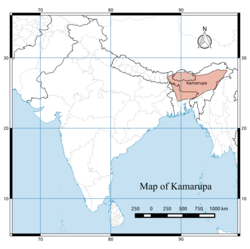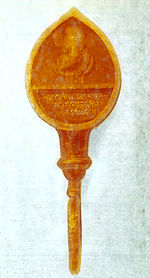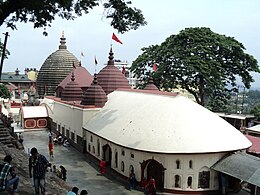User:Dhruv Hojai/sandbox
For the ancient pejorative term for foreign people in India, see Mleccha
Kamarupa Kingdom Mlechchha dynasty | |||||||||
|---|---|---|---|---|---|---|---|---|---|
| 650 CE–900 CE | |||||||||
 Kamarupa Map | |||||||||
| Capital | Harruppesvar (present-day Tezpur) | ||||||||
| Religion | Polytheism | ||||||||
| Government | Monarchy | ||||||||
| Maharajadhiraja | |||||||||
• c. 650 - c. 670 | Salasthamba | ||||||||
• c. 815 – c. 832 | Harjjaravarman | ||||||||
• c. 890 – c. 900 | Tyagasimha | ||||||||
| Historical era | Classical India | ||||||||
• Established | 650 CE | ||||||||
• Disestablished | 900 CE | ||||||||
| |||||||||
The Mlechchha dynasty[1] (c. 650 - 900) ruled Kamarupa from their capital at Harruppesvar in the present-day Tezpur, Assam,[2] after the fall of the Varman dynasty. The rulers were non-Indo-Aryan local chieftains, and like all other claimed lineages, their lineage from Narakasura was constructed to accord legitimacy to their rule.[3] According to historical records, there were twenty one rulers in this dynasty, but the line is obscure and the names of some intervening rulers are not known.[4]
The Mlechchha dynasty in Kamarupa was followed by the Pala kings.
Origins
[edit]It is not clear how Salasthambha, the first of this dynasty, came to power.[5] An inscription from the reign of a king from the later Pala dynasty claims Salasthambha was a lord of the mlechchhas,[6] which many scholars have interpreted to mean that Salasthambha was a mlechchha himself. Salasthambha is first mentioned in an inscription 175 years into the rule of the dynasty.[7]
Suniti Kumar Chatterji claims that Salastambha(650-670) was a Bodo-Kachari chief of Mech (Sanskritized as Mleccha)[8][9][10] [11].
According to some historians, the remnant of the Mlechchha kingdom formed the later Kachari kingdom[12][13].
Rulers
[edit]The grants of Ratnapala give the list of 21 kings from Salastambha to his line. [4]
- Salastamba (650-670)
- Vijaya alias Vigrahastambha
- Palaka
- Kumara
- Vajradeva
- Harshadeva alias Harshavarman (725-745)
- Balavarman II
- Jivaraja
- Digleswaravarman
- Salambha[15]
- Harjjaravarman (815-832)
- Vanamalavarmadeva (832-855)
- Jayamala alias Virabahu (855-860)
- Balavarman III (860-880)
- Tyagasimha (890-900)
| Part of a series on the |
| History of Kamarupa |
|---|
 |
| Ruling dynasties |
References
[edit]- ^ Though mlechchha is a derogatory word, Harjaravarman, a king of this dynasty, explains the term (though illegible) in the Hayunthal copper plates (Sharma 1978:P.91).
- ^ (Sen 1999:P.304)
- ^ (Shin 2011:P.183)
- ^ a b (Ray:P.242)
- ^ "(W)hen exactly Salasthambha occupied (the throne of Kamarupa) and under what circumstances cannot be determined in the present state of insufficient information." (Sircar 1990:122)
- ^ "Salasthambha is called the lord of the Mlechchhas in Ratnapalal's grant of the first half of the 10th century." (Sircar 1990:124)
- ^ (Sircar 1990:125)
- ^ (Chatterji 1951:97)The distinct mention of Sala-stambha as being a lord of the Mlecchas, as in the Bargaon copper-plate of the 19th century, would appear to make it clear that he was a Bodo chief of the Mèch tribe (Sanskritised as Mlēccha), who followed Bhaskara-varman in assuming the rulership of Assam
- ^ (Gait 1906:243)It is not improbable that at one time the major part of Assam and North-Bengal formed a great Bodo Kingdom, at least, the mleccha kings mentioned in copper plate inscription belong to the Kachari or some closely allied tribe.
- ^ (Shin 2011:178)According to D.C. Sircar, 'Mleccha' may be sanskritized form of tribal name 'mech'
- ^ (Nath 1989:7) K.L. Barua opines that Mleccha might be a sanskritized form of the term Mech. This view is also supported by Ed. Gait and S.K. Chatterji.
- ^ (Bhattacharjee 1992, p. 393)
- ^ (Baruah 1986:187–188)"(T)heThe Kacharis of North Cachar believe that they once ruled in Kamarupa and their royal family traced its descent from the Rajas of that country, from the line of Ha-tsung-tsa."
- ^ (Shin 2010:8)"Along with the inscriptional and literary evidence, the archaeological remains of the Kamakhya temple, which stands on top of the Nilacala, testify that the Mlecchas gave a significant impetus to construct or reconstruct the Kamakhya temple."
- ^ Pralambha, read from the Tezpur plates, can be corrected to Salambha, in light of the Parbatiya plates, (Sarma 1978, p. 105)
Bibliography
[edit]- Shin, Jae-Eun (2010). "Yoni, Yoginis and Mahavidyas : Feminine Divinities from Early Medieval Kamarupa to Medieval Koch Behar". Studies in History. 26 (1): 1–29. doi:10.1177/025764301002600101. S2CID 155252564.
- Nath, D. (1989). History of the Koch Kingdom, C. 1515-1615. Mittal Publications. ISBN 9788170991090.
{{cite book}}: CS1 maint: url-status (link) - Gait, Sir Edward Albert (1906), A History of Assam, Calcutta, Thacker, Spink & co., pp. 242, 243
- Baruah, S L (1986), A Comprehensive History of Assam (book), New Delhi: Munshiram Manoharlal Publishers
- Ray, H.C. (1931). Dynastic History Of Northern India Vol. 1. New Delhi: Munshiram Manoharlal Publishers.
- Bhattacharjee, J. B. (1992), "The Kachari state formation", in Barpujari, H. K. (ed.), The Comprehensive History of Assam, vol. 2, Guwahati: Assam Publication Board, pp. 391–397
- Sharma, M M (1978), Inscriptions of Ancient Assam, Guwahati: Gauhati University
- Sircar, D. C. (1990), "The Mlechchha Dynasty of Salasthambha", in Barpujari, H. K. (ed.), The Comprehensive History of Assam, vol. 1, Guwahati: Assam Publication Board
- Chatterji, S.K (1951). Kirata-Jana-Krti. Calcutta: The Asiatic Society.
- Endle, Sidney (1911). The Kacharis. London: Macmillan and Co.
- Shin, Jae Eun (2011). "Changing Dynasties, Enduring Genealogy: A Critical Study on the Political Legitimation in Early Medieval Kāmarūpa". Journal of Ancient Indian History. 27: 173–187.
- Sen, S.N. (1999). Ancient Indian History and Civilization. iNDIA: New Age International. ISBN 9788122411980.


